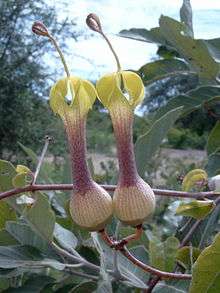Pollination trap
Pollination traps or trap-flowers are plant flower structures that aid the trapping of insects, mainly flies, so as to enhance their effectiveness in pollination. The structures of pollination traps can include deep tubular corollas with downward pointing hairs, slippery surfaces, adhesive liquid, attractants (often deceiving the insects by the use of sexual attractants rather than nectar reward and therefore termed as deceptive pollination[1]), flower closing and other mechanisms.
.jpg)
In many species of orchids, the flowers produce chemicals that deceive male insects by producing attractants that mimic their females. The males are then led into structures that ensure the transfer of pollen to the surfaces of the insects. Orchids in the genus Pterostylis have been found to attract male fungus gnats with chemical attractants and then trap them using a mobile petal lip.[2] The general observation of insects being trapped and aiding pollination were made as early as 1872 by Thomas Frederic Cheeseman[3] and did not go unnoticed by Charles Darwin who examined the adaptations of orchids for pollination.[4] Slipper orchids have smooth landing surfaces that allow insects to slide into a container from which a window of light leads the insect outwards through a narrow passage where the pollen transfer occurs. The structures found in large flowers such as those of Rafflesia and some Aristolochia are also evolved to attract and trap pollinators.[5]

Trap-flowers that produce deceptive sexual chemicals to attract insects may often lack nectar rewards. Many fly-trapping flowers produce the smell of carrion.[5]
Many members of the Arum family trap pollinators and the specific mechanisms vary with the insects involved.[6][7]
Plants in the genus Ceropegia attract pollinating small flies (usually female) in a wide range of families, including Milichiidae, Chloropidae, Drosophilidae, Calliphoridae, Ephydridae, Sciaridae, Tachinidae, Scatopsidae, Phoridae, and Ceratopogonidae, and the pollinaria always attach to their probosces.[8][9] An analysis of the scents emitted by Ceropegia dolichophylla showed the presence of spiroacetals which are rare in plants and common among insects. Milichid flies, which are kleptoparasites of arthropod predators, are attracted by these chemicals and become the pollinators of these plants.[10]
References
- ↑ Ferdy, Jean‐Baptiste; Gouyon, Pierre‐Henri; Moret, Jacques; Godelle, Bernard (1998). "Pollinator Behavior and Deceptive Pollination: Learning Process and Floral Evolution". The American Naturalist. 152 (5): 696–705. doi:10.1086/286200.
- ↑ Phillips, Ryan D.; Daniela Scaccabarozzi; Bryony A. Retter; Christine Hayes; Graham R. Brown; Kingsley W. Dixon & Rod Peakall (2014). "Caught in the act: pollination of sexually deceptive trap-flowers by fungus gnats in Pterostylis (Orchidaceae)". Annals of Botany. 113: 629–641. doi:10.1093/aob/mct295.
- ↑ Cheeseman TF (1872). "On the fertilisation of the New Zealand species of Pterostylis". Transactions and Proceedings of the New Zealand Institute. 5: 352–357.
- ↑ Darwin, C. R. (1877). The various contrivances by which orchids are fertilised by insects (2 ed.). London: John Murray.
- 1 2 Endress, Peter K. (1996). Diversity and Evolutionary Biology of Tropical Flowers. Cambridge University Press. pp. 119–121.
- ↑ Broderbauer, D; A. Weber & Anita Diaz (2013). "The design of trapping devices in pollination traps of the genus Arum (Araceae) is related to insect type". Botanical Journal of the Linnean Society. 172: 385–397. doi:10.1111/boj.12054.
- ↑ Cleghorn, Maude Lina (1914). "A note on the floral mechanism of Typhonium trilobatum.". Journal of the Asiatic Society of Bengal. 10: 421–424.
- ↑ Masinde, P. Siro (2004). "Trap-flower fly pollination in East African Ceropegia L. (Apocynaceae)". International Journal of Tropical Insect Science. 24 (1): 55–72. doi:10.1079/IJT20044.
- ↑ Ollerton, J., Masinde, S., Meve U., Picker M., Whittington A. (2009). "Fly pollination in Ceropegia (Apocynaceae: Asclepiadoideae): biogeographic and phylogenetic perspectives". Annals of Botany. 103: 1501–1514.
- ↑ A. Heiduk; I. Brake; T. Tolasch; J. Frank; A. Jürgens; U. Meve; S. Dötter (2010). "Scent chemistry and pollinator attraction in the deceptive trap flowers of Ceropegia dolichophylla". South African Journal of Botany. 76 (4): 762–769. doi:10.1016/j.sajb.2010.07.022.